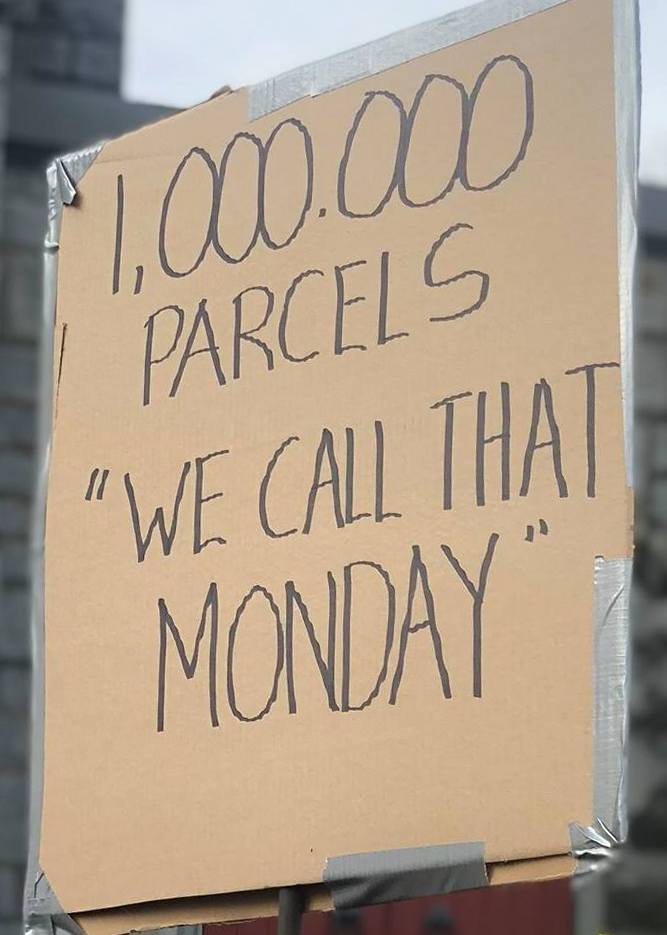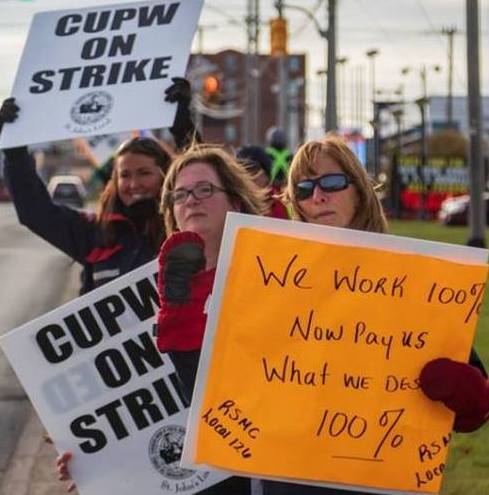|
Supplement
No. 17May 11, 2019
Canada Post's
Fraudulent Accounting Methods
Postal Workers
Produce Enormous
Value for the Economy and People
- K.C. Adams -

 The government of Canada should
salute the 67,466 workers of the Canada Post group of companies for
their hard work and contribution of value to Canada during 2018. The
year was difficult as Canada Post executive management refused to
negotiate a new contract necessitating unionized workers in the
Canadian Union of Postal Workers (CUPW) to organize rotating strikes.
The Trudeau government used its police powers to force an end to the
strikes. The legislated end of the strikes means the serious issues
confronting postal workers remain unresolved. This course of action
also covers up the immense value postal workers contribute to the
Canadian economy. The government of Canada should
salute the 67,466 workers of the Canada Post group of companies for
their hard work and contribution of value to Canada during 2018. The
year was difficult as Canada Post executive management refused to
negotiate a new contract necessitating unionized workers in the
Canadian Union of Postal Workers (CUPW) to organize rotating strikes.
The Trudeau government used its police powers to force an end to the
strikes. The legislated end of the strikes means the serious issues
confronting postal workers remain unresolved. This course of action
also covers up the immense value postal workers contribute to the
Canadian economy.
The fact is that, despite the difficulties, workers delivered 8.1
billion pieces of mail, parcels and messages to 16.4 million addresses
across Canada during the year for a realized gross income of $8.675
billion. According to the Canada Post accounts, each full and part-time
worker produced on average $128,583 of realized gross income (revenue)
for the company. This does not represent the actual value in work-time
and money that individual workers produced and transferred into social
product during the year. The realized gross income is the value in
money of postal workers' social product sold in exchange at specific
market prices.
Canada
Post's 2018 Annual Report, Financial Section
The
2018
yearly
accounts
from
Canada
Post
management
are
mostly meant for
propaganda purposes pushing whatever line favours the ruling oligarchs
at the moment. The accounts do not give a scientific rendering of the
work-time of workers to produce new value or the amount of old value
transferred into production from machines and material.
New
value
arises
from
the
actual
work-time
of
postal
workers and can be
calculated in standard work-time of the total hours worked to move
mail, parcels and messages from point A to point B. Using a modern
formula to determine the price of production of the social product, the
new value in work-time that workers produce can be calculated in money.
The
actual
new
value
workers
produce
through
their
work-time
and the amount
realized through the sale of the social product may not be the same.
The
amount realized of both the old and new value depends on two main
factors: the sale of the social product and its market price.
The
realized
gross
income
of
Canada
Post,
which
it
calls "revenue from
operations," may or may not represent the actual value of production.
This arises because the accounts do not explain or in any way elaborate
a scientific basis to calculate a retail price as payment for
transporting mail, parcels and messages and its relation to the actual
value workers produce. Nor do they discuss any subjective motive
regarding prices that should arise from the necessity to provide in the
spirit of nation-building a vibrant mail service equally for all
Canadians no matter where they live.
New
Value Postal Workers Produce
The
reproduced-value
workers
claim
as
wages
and
benefits
forms
part of the
new value they produce. Another part of the new value workers produce
is the added-value those in control of Canada Post and others who have
investments in the company expropriate as profit. Expropriation of new
value as profit takes many forms such as interest profit, enterprise
profit, rent profit, a portion of government's claims, and money given
to executives and directors, which in the case of Canada Post in 2018
was $12 million. A portion of new value can also be used to renew the
productive forces and fulfil Canada Post's mandate to serve equally all
addresses in Canada regardless of location, or be distributed for
investment in social programs and public services.
The
accounts
do
not
provide
a
scientific
rendering
of
the value workers
produce and transfer into social product, the price of production of
that value in money, how the various market prices for social product
are determined, and the distribution of the realized new value
workers produce and the old value from already-produced value workers
transfer into the social product.
Instead,
without
elaboration
the
accounts
begin
with
a
realized
amount of the
value received from customers stated as $8.675 billion in realized
gross income, which they call "revenue from operations." The realized
gross income from the total value workers produce is the amount
received in payment from customers for services rendered. The retail
prices do not necessarily represent the actual value of work-time of
workers to produce the social product. Also, the accounts do not
explain how Canada Post determined what the retail prices should be.
The
next
item
is
called
the
"cost
of
operations,"
which totals $8.784
billion. This amount is deducted from the first amount resulting in
what the accounts declare a "loss from operations" of $109 million.
 This presentation of
the value Canada Post workers produced in 2018, its realization and
distribution is a travesty and distortion of the modern reality. By
subjective sleight of hand, the accounts turn the value workers produce
and transfer moving the mail, parcels and messages into a "cost of
operations." What was all that work to move mail, parcels and messages
around the country if not work-time to produce new value that can be
measured with precision? The accounts turn the hard work of postal
workers producing value into a cost without blinking an eye and then
cover up their anti-worker self-serving deed by posturing as great
economists and captains of industry. Workers should have none of it and
denounce the entire accounts as anti-worker subjective rubbish. In this
modern era of socialized production, the Canada Post accounts hold no
merit and exist for an ulterior motive to attack the claims of postal
workers on the value they produce and to prepare public opinion to
privatize Canada Post even further and erase from memory Canada Post's
nation-building mandate to serve all Canadians equally no matter where
they live. This presentation of
the value Canada Post workers produced in 2018, its realization and
distribution is a travesty and distortion of the modern reality. By
subjective sleight of hand, the accounts turn the value workers produce
and transfer moving the mail, parcels and messages into a "cost of
operations." What was all that work to move mail, parcels and messages
around the country if not work-time to produce new value that can be
measured with precision? The accounts turn the hard work of postal
workers producing value into a cost without blinking an eye and then
cover up their anti-worker self-serving deed by posturing as great
economists and captains of industry. Workers should have none of it and
denounce the entire accounts as anti-worker subjective rubbish. In this
modern era of socialized production, the Canada Post accounts hold no
merit and exist for an ulterior motive to attack the claims of postal
workers on the value they produce and to prepare public opinion to
privatize Canada Post even further and erase from memory Canada Post's
nation-building mandate to serve all Canadians equally no matter where
they live.
An
Examination of Canada Post's Published Accounts
A
modern
accounting
method
begins
from
the
present,
which
is the
work-time of workers producing new value and transferring old value
from machines and material into production. The human factor and its
work-time is the essential feature that sets the productive forces into
motion and produces value. Any accounting of production must start from
the work-time of the human factor.
Canada
Post's
accounts
are
far
from
such
a
rendering.
The first item in
imperialist accounting is the revenue from operations, which is the
realized gross income from exchange of the social product the workers
have produced, the realized amount of whatever goods or services can be
sold and their market price. The second item in the accounts is a
so-called cost of operations. Any factor that from the point of view of
those in control takes money from the realized gross income is viewed
as a cost to them and their bottom line. The financial oligarchy
considers its right to expropriate the value workers produce as the aim
of the economy. All other claims on the value workers produce are
considered a cost to those in control, even other factions of the
oligarchy such as moneylenders.
The
so-called
costs
of
operations
include
most
importantly
the
claims of
workers, their wages and benefits, which they have reproduced through
their work-time. The costs also include the amount of old value from
machines and material consumed in the productive process and
transferred into the social product, which should be returned when the
social product is sold.
The
third
item
in
the
accounts
is
the
profit
or loss from operations, which
merely deducts the second item, the "cost of operations" from the first
item, the "revenue from operations" (realized gross income) and any
expropriation of added-value by those other than those in control of
the enterprise such as moneylenders, landlords and government.
This
rendering
obscures
and
buries
the
source
of
new
and old value within
the social product, which is the working class itself and its work-time
using means of production. The accounts begin from the sale of the
social product, which in reality is a realization in money of the value
workers have already produced through their work-time.
Imperialist
accounting
transforms
the
working
class
from
its
role
as the essential
creator of value into a cost of production for those in control. It
puts the financial oligarchy into the centre of the economy from where
it can manipulate the economy and the enterprises it controls to serve
its narrow interest for maximum profit and to perpetuate its class
privilege and exploitation of the working class. The accounts become a
propaganda weapon for whatever project those in control have in mind,
such as to attack the claims of the working class on the value it
produces and in the case of Canada Post, the added dimension of
privatization and to destroy its original socially responsible
state-organized mandate to serve all Canadians equally regardless of
location as an important aspect of nation-building.
The
fatal
flaw
in
Canada
Post's
accounts
stems
from
the anachronistic
outlook of those in control. The outlook of the financial oligarchy,
executive managers and government views already produced social value
and the control of that value as the starting point for the production
of new value from which it can expropriate profit. This starting point
serves the aim of the financial oligarchy to defend and expand its
control of the productive forces of the country and the social product
workers produce. This negates the role of the work-time of the actual
producers, the postal workers themselves, as the essential human factor
setting in motion the productive forces to produce value and the
necessity to put the well-being of the people and society as the aim
and priority of the socialized economy.
For
the
financial
oligarchy
the
work-time
of
the
working
class and its
claim on the value it produces become a cost of production reducing the
amount available for those in control to expropriate as profit. In
fact, the financial oligarchy, which can be characterized as a
non-working class, has become obsolete and a barrier to the development
of the productive forces to serve and guarantee the well-being and
rights of the people and open a path forward for society to humanize
the workplace and natural and social environment, and put an end to
class privilege and the exploitation of humans by humans.
To
find
an
objective
base
for
a
market
price,
Canada Post must first
determine the actual price of production of the social product workers
produce. A modern formula to determine a price of production exists.
The formula requires proper accounting of all the factors involved in
the production and reproduction of new value and the transfer of old
value from machines, buildings and material into the social product.
Contrasting
Accounting
Methods
The
already-produced
social
value
comprises
the
fixed
assets
such
as
buildings, machinery, and accumulated money owned and controlled by
Canada Post.[1] Canada Post has a
state-organized mandate and right to mobilize workers to use those
means of production to deliver mail, parcels and messages equally to
all Canadian addresses no matter where they live or work.
Canada
Post
workers
are
put
to
work
on
those
fixed assets and bring them to
life to produce a service for Canadians. The working class is the
essential ingredient or human factor to set the productive forces in
motion to produce value. Instead of beginning the Canada Post accounts
from the work-time of workers producing value, the starting point of
the imperialist accounting method is the end result or exchange of the
social product and the realized value the enterprise receives as gross
income, which it calls "revenue from operations." The financial
oligarchy then considers all claims on the realized value, the gross
income or "revenue from operations" as expenditures or costs reducing
the realized value down to either a profit or loss for those who own
and control the already-produced fixed assets and other social wealth
of the enterprise.
 Contrasting
accounting methods reflect the social being and conflicting aim and
outlook of the two main social classes in Canada, the working class and
financial oligarchy. A modern accounting method serving the actual
producers, the working class, begins from the work-time of the workers
for the period examined. The work-time of workers using the
already-produced value produces new value, which is the sum of
reproduced-value and added-value and equivalent to the standard
work-time required to produce a certain quality and quantity of social
product. Added to the new value is the amount of old value from the
already-produced value of buildings, vehicles, machines, equipment and
material that workers transfer into the social product. Contrasting
accounting methods reflect the social being and conflicting aim and
outlook of the two main social classes in Canada, the working class and
financial oligarchy. A modern accounting method serving the actual
producers, the working class, begins from the work-time of the workers
for the period examined. The work-time of workers using the
already-produced value produces new value, which is the sum of
reproduced-value and added-value and equivalent to the standard
work-time required to produce a certain quality and quantity of social
product. Added to the new value is the amount of old value from the
already-produced value of buildings, vehicles, machines, equipment and
material that workers transfer into the social product.
A
modern
formula
to
determine
a
price
of
production
using an average rate
of profit reflecting the added-value workers produce at the economy's
level of productivity could then find the monetary equivalent of the
total value of the social product workers produce. The price of
production forms the objective basis for determining retail or market
prices, which in the case of Canada Post would be adjusted according to
the mandate of the enterprise to serve all Canadians equally and
contribute to nation-building.
The
imperialist
accounting
method,
rather
than
recognizing
the
work-time
of
workers as the means to produce new value and unleash the productive
power of fixed and circulating already-produced value, turns workers'
work-time producing value and their claim on the new value they produce
into a cost of producing the value they produce! This
imperialist-centred method of accounting allows those who own and
control the already-produced value to engage in propaganda warfare
against the rightful claims of the working class on the new value they
produce and obscure how and where new value arises. It seeks to
perpetuate the outmoded role and class privilege of the financial
oligarchy and block the empowerment of the working class in the
political, economic and social affairs of the country.
In
the
case
of
Canada
Post,
the
2018
accounts
show a loss and no value as
profit for those in control of the enterprise and
therefore the entire year of hard work is considered in a negative
light. According to this accounting method, the loss arises mainly from
the claims of the workers on the value they produce, their class
struggle to defend themselves through rotating strikes and the pay
equity arbitration decision.
Those
in
control
lament
the
perceived
loss
as
it
reduces the original
already-produced value and social wealth of the enterprise. Those in
control of the already-produced value seek to expand the social value
they control. The workers are blamed for incurring the so-called loss
because their claim on the new value they produce directly conflicts
with the imperialist aim of maximum profit to serve and strengthen the
class privilege of the financial oligarchy. The solution to the loss,
according to the imperialists in control, is to attack the working
class using police powers when necessary to force a reduction of what
belongs to workers by right, and, when it suits the narrow interests of
the oligarchs in control, further privatize the public enterprise.
 The financial
oligarchy has abandoned any notion of nation-building and instead wants
to seize direct control of the movement of mail, parcels and messages
outside any state-organized mandate to serve Canadians equally. A
method in this attack is to privatize and fragment the post office into
increasingly competing segments that have no connection or allegiance
to the original mandate of Canada Post to serve all Canadians equally
no matter where they reside or engage in business. The financial
oligarchy has abandoned any notion of nation-building and instead wants
to seize direct control of the movement of mail, parcels and messages
outside any state-organized mandate to serve Canadians equally. A
method in this attack is to privatize and fragment the post office into
increasingly competing segments that have no connection or allegiance
to the original mandate of Canada Post to serve all Canadians equally
no matter where they reside or engage in business.
Those
in
control
refuse
to
recognize
the
legitimate
claims
of workers on the
new value they produce. The imperialist aim of private profit even
within a public enterprise puts those in control into contradiction not
only with postal workers but also with the official mandate of Canada
Post to serve the people equally. This means postal workers have to
strengthen their organized resistance to attacks on what belongs to
them by right, and reach out to the Canadian public and rally them in a
broad defence of nation-building and a public post office that upholds
its social responsibility to serve the people equally and not a
privileged few for private profit.
Information
Gleaned
or
Not
from
the
2018
Annual
Accounts of Canada Post
Total
work-time of postal workers in standard work-hours = not reported
Total
new value of social product workers produce = not reported
Total
old value of already-produced value workers transfer into the social
product = neither the total reported nor itemized
Price
of production = not reported as a whole or in its particular forms such
as letter mail and parcels
Total
gross income from value realized in payment from customers for social
product = $8.675 billion (recorded as "revenue from operations")
The
refusal
of
Canada
Post
to
negotiate
a
new
collective agreement with
workers and their union CUPW and the subsequent rotating strikes is
posited as having contributed to an estimated realized gross income
shortfall (loss) of $195 million.
Total
claim of workers on the new value they produced (wages and salaries of
active workers) = $4.364 billion (Reported as "cost of operations"
under the subhead "cost of labour")
Claim
of active and retired workers for benefits, including pensions, on the
new value workers produced = $1.620 billion (Reported as "cost of
operations" under the subhead "cost of employee benefits")
Total
claims of active and retired workers on new value workers produced =
$5.986 billion
 Because of the pay
equity ruling, the total recorded claim of workers for the year 2018
misrepresents the facts. For the Canada Post segment, the pay equity
arbitration ruling for Rural and Suburban Mail Carriers gave CUPW
members an additional $550 million in pay owed to them for the new
value they produced of which $420 million was recorded in 2018.
Although recorded as paid in 2018, this amount in fact includes $280
million retroactive to January 1, 2016. The accounts for 2016 and 2017
at the very least should have been redone to record the actual realized
claims of workers for those years and not have been used to fabricate a
"loss" of $195 million in 2018, which management has used in its
propaganda war against workers and for privatization. The ongoing
annual amount from the pay equity ruling will be an increase in
workers' claim on the new value they produce of $140 million.[2] Workers should note that an increase in
their claim on the new value they produce results essentially in a
reduction of an equivalent portion of added-value within the new value
and not in an equivalent increase in the total value and subsequent
price of the social product. Because of the pay
equity ruling, the total recorded claim of workers for the year 2018
misrepresents the facts. For the Canada Post segment, the pay equity
arbitration ruling for Rural and Suburban Mail Carriers gave CUPW
members an additional $550 million in pay owed to them for the new
value they produced of which $420 million was recorded in 2018.
Although recorded as paid in 2018, this amount in fact includes $280
million retroactive to January 1, 2016. The accounts for 2016 and 2017
at the very least should have been redone to record the actual realized
claims of workers for those years and not have been used to fabricate a
"loss" of $195 million in 2018, which management has used in its
propaganda war against workers and for privatization. The ongoing
annual amount from the pay equity ruling will be an increase in
workers' claim on the new value they produce of $140 million.[2] Workers should note that an increase in
their claim on the new value they produce results essentially in a
reduction of an equivalent portion of added-value within the new value
and not in an equivalent increase in the total value and subsequent
price of the social product.
Fixed
transferred-value from already-produced fixed assets such as vehicles,
buildings, machines and equipment = $311 million
Fixed
transferred-value
is
the
amount
of
value
workers
transfer
into
production from fixed assets. The accounts report this as a "cost of
operations" under the subhead "depreciation and amortization."
Circulating
transferred-value from already-produced material assets consumed in the
production process, such as electricity and fuel for vehicles = not
reported as a separate item.
Circulating
transferred-value
is
the
amount
of
value
workers
transfer
into
production from already-produced material consumed during the
production process.
Circulating
transferred-value from material consumed is contained within "other
operating costs" but not separated out and itemized = $2.488 billion
The
use
of
the
term
"cost"
to
account
for
both fixed and circulating
transferred-value is suspect for modern accounting. A definition that
would make some sense is "outlay" with the expectation of a return of
the outlaid money upon realization of the social product. The realized
return of the outlay should make the final result, at least the
expectation, neutral or "equivalent in value" of the outlay and
not in the final analysis a cost to the enterprise.
The
value
from
already-produced
value
workers
transfer
into
production,
which
the enterprise buys, should as a rule return to the enterprise
through realized value once the social product is sold. The end result
is that the value from machines and material transferred into
production and then realized and returned in payment should be
approximately equivalent and not be a cost to the enterprise other than
in the sense of the time between the outlay of the money spent and its
return. This could entail borrowing, which means the moneylender
expropriates a portion of the added-value workers produce.
In
general,
if
the
realized
amount
does
not
amount
to near the price of
production because some of the social product remains unsold or the
retail prices are too low then that reveals a deeper problem with the
enterprise or sector that needs to be addressed.[3]
Selling,
administrative and other = $538 million
This
section
of
the
accounts
should
be
categorized
so
as to determine if the
work-time involved is productive or not. This becomes important when
determining a price of production and the amount of added-value or
total profit.
Interest
claim from money lenders on new value postal workers produced = $44
million
This
amount
is
not
reported
as
part
of
the
profit the financial oligarchy
expropriates but falsely as a portion of the "cost of operations."
Interest profit comes out of the added-value or total profit that
workers produce from their work-time, which is part of the new value
workers produce. Imperialist accounting from the point of view of those
in control of the enterprise falsely puts interest profit as a cost
because it comes out of the total profit (added-value) thus reducing
the portion going as enterprise profit.
Outstanding
loans to money lenders = $1.025 billion
Claim
of executive managers and members of the Board of Directors (defined in
Canada Post accounts as Key Management Personnel) = $12 million
Note
that
this
executive
profit
is
not
reported
as
profit expropriated by
those in control from the new value workers produce but falsely listed
as a "cost of operations," which contributes to the reported loss.
Such
"largesse"
with
Canada
Post's
revenue
from
new
value
is a form of
corruption. The corruption is broadened through privatization and the
bringing of representatives of private interests into executive
management and the Board of Directors. Many people have exposed as
corruption the participation of the main private owner of Purolator as
a member of the Board of Directors of the Purolator segment of Canada
Post Corporation and the subsequent lucrative contract for air services
given to the private owner's company KF Aerospace. Corruption also
deepens as more fixed and circulating
already-produced value, such as vehicles, sorting machines and
computers, is purchased from favoured global imperialist enterprises
and contractors rather than having those assets manufactured within the
national economy using Canadian public enterprises.
Social
Reproduced-Value
 An issue of great
importance across Canada is the absence of any specific payment coming
from big companies for the social value embedded in workers. The
education and health care of workers comes mostly from public
institutions that produce this social value. Canada Post should
acknowledge and pay for the social value embedded in workers' capacity
to work and subsequently reproduced as new value while working. Social
reproduced-value is part of the new value workers produce and should be
exchanged with direct payment to the public enterprises that produced
it and reported as such in the accounts. An issue of great
importance across Canada is the absence of any specific payment coming
from big companies for the social value embedded in workers. The
education and health care of workers comes mostly from public
institutions that produce this social value. Canada Post should
acknowledge and pay for the social value embedded in workers' capacity
to work and subsequently reproduced as new value while working. Social
reproduced-value is part of the new value workers produce and should be
exchanged with direct payment to the public enterprises that produced
it and reported as such in the accounts.
The
companies
should
pay
for
social
reproduced-value
directly
to
the
education, health and other social institutions and sectors producing
the social value within the human factor as capacity to work. Social
programs should not have to receive the bulk of their revenue from
governments through taxation.
Claims
for
social
reproduced-value
form
part
of
the
overall
claim of the
working class on the value it produces in exchange for its capacity to
work. Social reproduced-value forms part of the amount that should be
used to sustain all members of the working class at a Canadian standard
from birth to passing away.
The
absence
of
any
accounting
of
social
reproduced-value
and
its
realization by the companies that consume the value is a serious
problem confronting the economy. The imperialists are unwilling to
resolve the problem. This stems from their aim to serve their private
interests at the expense of the well-being and security of working
people and the socialized economy as a whole and the other enterprises
and parts within the economy, which are considered competitors.
Canada
Post Segmented Accounts
Revenue
from operations (gross income from realized social product) = $6.620
billion
Number
of workers (includes part-time workers and those on unpaid leave) =
53,330
Realized
gross income of segment (revenue) = $6.620 billion
Realized
gross income per worker = $124,133 (This does not represent the actual
value in work-time and money that individual workers produced and
transferred into social product during the year. The realized gross
income is the value in money of postal workers' social product sold in
exchange at specific market prices.)
The
amount paid for "non-labour collection, processing and delivery"
(Canada Post segment only) = $1.025 billion
The
accounts
read,
"Contracted
collection,
processing
and
delivery
costs
increased
by $46 million or 4.3 per cent in 2018 (to $1.025 billion)."
No further details on this amount are given leaving readers to wonder
how large contracted and privatized work has become. Mention is made
elsewhere in the accounts of outstanding payments due and difficulties
in receiving payments in time from contracted or privatized services
such as retail outlets. Of the 6,100 post offices across the country,
private dealers operate 2,400.
Purolator
Purolator
gross income from realized value (revenue from operations) = $1.8
billion (Purolator is 9 per cent privately owned. Purolator's gross
income makes up 21 per cent of the Canada Post Group.)
Workers'
claim for reproduced-value on new value they produced (wages and
salaries wrongly labelled as part of "cost of operations") = $830
million
The
amount paid for "non-labour collection, processing and delivery" at
Purolator segment = $859 million
This
must
include
fixed
transferred-value
from
buildings,
machines
and
vehicles,
and circulating transferred-value from fuel etc, although no
details are provided. A large portion must be for payments to
contractors, such as to the airline company owned by the private
interests that own part of Purolator and for other delivery contractors.
Number
of workers (includes part-time workers and those on unpaid leave) =
9,857
Realized
gross income of segment (revenue) = $1.8 billion
Realized
gross income (revenue) per worker = $182,611
SCI
Group (Logistics)
SCI
Group (logistics) gross income from realized value ("revenue from
operations") = $322 million (per cent of total Canada Post business =
3.3 per cent)
Workers'
claim for reproduced-value on new value they produced (wages and
salaries) = $163 million
"Non-labour
costs" (SCI segment) = $139 million
No
details
are
provided
for
the
"non-labour
costs."
Notes
1. Already-produced
fixed assets of Canada Post:
Fixed
assets
include
land,
buildings,
vehicles,
plant
equipment,
sales
counters,
office furniture and other equipment etc, which 67,466
workers set in motion to produce value. The number of workers excludes
temporary, casual and term employees. Workers work in every urban,
rural and remote community across Canada.
Almost
7,000 retail post offices
Vehicles
= 18,000
Canada
Post
segment
alone
owns
and
controls:
21
processing plants containing equipment
480 carrier depots
22,519 street letter boxes
205,500 community mailbox sites
1.7 million post office boxes including general delivery
5,300 parcel lockers
Total
assets of Canada Post Group of companies valued at = $9.197 billion
Use
of new value workers produced to invest in fixed assets in 2018 = $387
million
Depreciation
of fixed assets in 2018 = $311 million (Workers transferred this amount
of old value, fixed transferred-value, into the social product.)
Difference
between investment in fixed assets and depreciation = $76 million (This
investment from the new value workers produced increased the total
value of Canada Post fixed assets by $76 million.)
No
specific
amount
is
given
for
circulating
transferred-value
of
material
workers transferred into the social product. The amount is lumped in
with "cost of operations" and the subgroup "non-labour costs."
2. Canada Post
executives and both liberal and conservative cartel party federal
governments have been fighting tooth and nail for decades against any
arrangement and resolution of the Canada Post pay equity dispute
acceptable to workers and their union CUPW. The longstanding opposition
of federal governments and executives against pay equity for rural and
suburban workers forced postal workers to seek justice through job
actions, expensive court filings and arbitration.
Instead
of
apologizing
for
having
pay
inequity
an
official
government and
company policy for decades, Canada Post executives moan bitterly of the
enterprise suffering a "loss" in 2018 because the decision of the
arbitrator forced retroactive back-pay to rural and suburban workers to
rectify in a small way the pay inequity they have endured for decades.
Not content to throw abuse at workers for "causing a loss for the
enterprise" from their just claim on what belongs to them by right from
the value they produce, in a statement introducing the 2018 accounts,
the Canada Post executives write, presumably with a straight face and
no sense of shame because their imperialist outlook would prevent it,
"Pay equity is a basic human right and any pay disparity on the basis
of gender is unacceptable to Canada Post." Yeah right, you hypocrites!
3. The issue of
value from machine use is obscured under imperialist accounting. An
underlying suggestion of the imperialists, or rather distortion, is
that
machines themselves produce new value and do not merely transfer their
already-produced value into production. More productivity through
machine use increases the total social product in relation to
work-time. However, machine use does not create more value than the old
already-produced value embedded in the machines and transferred into
the social product. The portion of the value of the social product
contributed by machines is equivalent to the value of the machines
themselves and their depreciation through use.
This
differs
from
human
productive
power,
which
has
the
capacity to create
new value through work-time. The new value of human work-time
reproduces its own value, called reproduced-value, plus an additional
amount called added-value. The total of reproduced-value and
added-value is the new value workers produce through their work-time.
Human work-time reproduces the value contained in its capacity to work,
the value that is embedded in the human factor and its capacity to work
and creates the possibility for the human factor to work again. In
addition to the reproduced-value, human work-time produces an
additional amount called added-value, which under imperialism forms the
basis for private profit and the class privilege of the financial
oligarchy. To attain its emancipation, the working class must gain
control over the added-value so that it controls the entire new value,
the entire social product it produces.

PDF
PREVIOUS
ISSUES | HOME
Website: www.cpcml.ca
Email: editor@cpcml.ca
|

